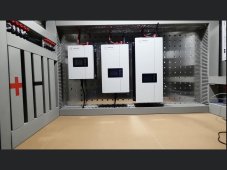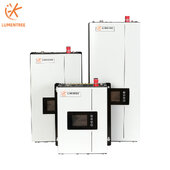Ditto for the blue GTIL2 1000W I bought in March…ok the GTI2 SUN 1000W i ordered 6 weeks ago is blue and also has the scheduling feature built-in
You are using an out of date browser. It may not display this or other websites correctly.
You should upgrade or use an alternative browser.
You should upgrade or use an alternative browser.
Recommended vendors for GTIL inverters?
- Thread starter fafrd
- Start date
Cheap 4-life
My body is 2.63 trillion volts, .07v per cell
Awesome! my mistake. I forgot the newer versions also started adding TOU. Probably because I’m not interested in the TOU functionality due to running them 24/7.ok the GTI2 SUN 1000W i ordered 6 weeks ago is blue and also has the scheduling feature built-in
that will work a lot better for u then using controllable outlets or relays etc..
it’s best to cut off the plug and hard wire these inverters directly to a breaker via a wiring trough or a wall pas through of some kind. An appliance being accidentally unplugged while using power is no problem but a power supply (inverter) being accidentally unplugged while supplying power can damage these inverters. Also outlets go bad causing damage to the inverters or just faulty connections. I have replaced many bad outlets for custoners
Last edited:
So does that mean that there is no functionality difference between the new ‘white’ GTIL2s and newer production of the older ‘blue’ GTIL2s, just a cosmetic difference?Awesome! my mistake. I forgot the newer versions also started adding TOU.
Probably because I’m not interested in the TOU functionality due to running them 24/7.
that will work a lot better for u then using controllable outlets or relays etc..
it’s best to cut off the plug and hard wire these inverters directly to a breaker via a wiring trough or a wall pas through of some kind. An appliance being accidentally unplugged while using power is no problem but a power supply (inverter) being accidentally unplugged while supplying power can damage these inverters. Also outlets go bad causing damage to the inverters or just faulty connections. I have replaced many bad outlets for custoners
Cheap 4-life
My body is 2.63 trillion volts, .07v per cell
My understanding is that the new Lumentree has software to control the power over the 9 pin connector.. And TOU control. that’s what I have been told on the Facebook group. Also as far as I know the new Lumentree isn’t ATM sold to the USA. The Facebook member was from GermanySo does that mean that there is no functionality difference between the new ‘white’ GTIL2s and newer production of the older ‘blue’ GTIL2s, just a cosmetic difference?
Not familiar with Lumentree - is that the name of a new GTIL-like product which also happens to be white?My understanding is that the new Lumentree has software to control the power over the 9 pin connector.. And TOU control. that’s what I have been told on the Facebook group. Also as far as I know the new Lumentree isn’t ATM sold to the USA. The Facebook member was from Germany
Cheap 4-life
My body is 2.63 trillion volts, .07v per cell
Cheap 4-life
My body is 2.63 trillion volts, .07v per cell
They also have a 600w version
Are they related to the GTILs sold by Sun or is this just another similar offering by another manufacturer?They also have a 600w version
Cheap 4-life
My body is 2.63 trillion volts, .07v per cell
I can only speculate that they are all made by the same manufacturer. Then the individual rebranders ask for additional changes or they change somethings themselvesAre they related to the GTILs sold by Sun or is this just another similar offering by another manufacturer?
Lumentree claims to be the manufacturer in this listing :
Lumentree 600w 65v Grid Tie Solar Inverter With Power Limiter On Grid Inverter Dc Ac Home Use Solar Inverter - Buy Solar Inverter 2kw Inverter Solar Solar Panels Inverter 1000w Inverter Solar,On Grid Solar Inverter Soler Inverter Solar Home System Ch
Lumentree 600w 65v Grid Tie Solar Inverter With Power Limiter On Grid Inverter Dc Ac Home Use Solar Inverter - Buy Solar Inverter 2kw Inverter Solar Solar Panels Inverter 1000w Inverter Solar,On Grid Solar Inverter Soler Inverter Solar Home System China Wholesale Single Phase Solar...
www.alibaba.com
that actually would be fantasticMy understanding is that the new Lumentree has software to control the power over the 9 pin connector.. And TOU control. that’s what I have been told on the Facebook group. Also as far as I know the new Lumentree isn’t ATM sold to the USA. The Facebook member was from Germany
Cheap 4-life
My body is 2.63 trillion volts, .07v per cell
Apparently all the newer updated versions of the GTIL2 now have TOU capabilities. I sized my system to stay running 24/7 to cover all my loadsthat actually would be fantastic
I have a newer SUN GTIL2 with TOU capability but tried to use it for the first time and is not working the way I though it would.Apparently all the newer updated versions of the GTIL2 now have TOU capabilities. I sized my system to stay running 24/7 to cover all my loads
I checked the first box and programmed 16:00 and 21:00 thinking that would cause it to put out 0W until 4pm and then run until 9pm or battery discharging to inverter LVD, whichever came first.
Just checked at 13:00 / 1pm and the inverter was generating away, so it’s obviously not waiting for 16:00 / 4pm to start generating.
I also checked the internal clock to confirm it is accurate.
What am I doing wrong?
What are those programmable time slots intended to control and what is supposed to happen when there is no time slot active?
Cheap 4-life
My body is 2.63 trillion volts, .07v per cell
I can only speculate that you possibly have it backwards. The time slot might be when the inverter is offI have a newer SUN GTIL2 with TOU capability but tried to use it for the first time and is not working the way I though it would.
I checked the first box and programmed 16:00 and 21:00 thinking that would cause it to put out 0W until 4pm and then run until 9pm or battery discharging to inverter LVD, whichever came first.
Just checked at 13:00 / 1pm and the inverter was generating away, so it’s obviously not waiting for 16:00 / 4pm to start generating.
I also checked the internal clock to confirm it is accurate.
What am I doing wrong?
What are those programmable time slots intended to control and what is supposed to happen when there is no time slot active?
Somehow the times I programmed got lost.I can only speculate that you possibly have it backwards. The time slot might be when the inverter is off
It required a reboot to take effect but it now seems to be working as I expected.
I assumed each slot was for time window you wanted the GTIL ON - are some of the time slots to program when the inverter is OFF???
Cheap 4-life
My body is 2.63 trillion volts, .07v per cell
Idk if some of the slots are for off. I have never used the newer versions. Doing reboot is sometimes necessary to make the reboot and cutoff voltages work as intended so it makes sense that a reboot is required for other settingsSomehow the times I programmed got lost.
It required a reboot to take effect but it now seems to be working as I expected.
I assumed each slot was for time window you wanted the GTIL ON - are some of the time slots to program when the inverter is OFF???
Cheap 4-life
My body is 2.63 trillion volts, .07v per cell
you can also communicate with Mcrey on the Facebook groupthis is Mcrey which from lumentree
any question about G2 can sent me
blue one is generation 1 and white is generation 2
wish everyone have a nice day
thank you pay attention to lumentree SUN-G2
View attachment 186592
Last edited:
peterwareing
New Member
- Joined
- Dec 4, 2019
- Messages
- 23
I can assist u. I am the moderator of the Facebook group regarding these inverter. 36v is much better than 24v. 24v is at the lowest operating voltage of the GTIL2. That makes the inverter constantly have to use more amps than it woulld with a 36v battery which causes the inverter to work harder, which would shorten its life. I use two of the 2kw versions powered by a 60v battery for my split phase home, and have been 4 years. The inverters cover almost all of my homes power usage 24/7... I just let them run. I use an Outback fm80 charge controller. They make a cheaper fm60. It doesn’t have BT or
Hi there. A little late to the party sorry. Would this situation also arise due to an over voltage situation with one cell exceeding the BMS limit OVP?The one thing I learned from painful experience is that these GTILs are very susceptible to damage when BMS protection kicks in.
It’s right to there in the manual but I did not properly understand the implications: ‘always disconnect AC before disconnecting DC. Failure to do so can result in electrical damage to your inverter.’
My BMS low voltage disconnect protection kicked in only one in 3 years but the result was stinky smoke and a fried GTIL.
So if using these inverters, it’s very important to assure the inverter hits it’s battery-level low voltage disconnect before any cell in the battery can discharge below BMS low voltage disconnect level (meaning the battery needs to be well-balanced near the lower knee…).
Battery was getting down near disconnect voltage, large load turned on causing GTIL to surge to near max output causing battery current to surge causing lowest SOC cell to drop below BMS LVD of 2.5V causing BMS to abruptly shut off battery causing GTIL to fry.
Make sure BMS protection can never kick in while one of these GTIL inverters is generating AC power (again, it’s right there in the manual).
The one thing I learned from painful experience is that these GTILs are very susceptible to damage when BMS protection kicks in.
It’s right to there in the manual but I did not properly understand the implications: ‘always disconnect AC before disconnecting DC. Failure to do so can result in electrical damage to your inverter.’
My BMS low voltage disconnect protection kicked in only one in 3 years but the result was stinky smoke and a fried GTIL.
So if using these inverters, it’s very important to assure the inverter hits it’s battery-level low voltage disconnect before any cell in the battery can discharge below BMS low voltage disconnect level (meaning the battery needs to be well-balanced near the lower knee…).
Battery was getting down near disconnect voltage, large load turned on causing GTIL to surge to near max output causing battery current to surge causing lowest SOC cell to drop below BMS LVD of 2.5V causing BMS to abruptly shut off battery causing GTIL to fry.
Make sure BMS protection can never kick in while one of these GTIL inverters is generating AC power (again, it’s right there in the manual).
Yes.Hi there. A little late to the party sorry. Would this situation also arise due to an over voltage situation with one cell exceeding the BMS limit OVP?
Any abrupt disconnect by the BMS while the GTIL is on-grid and generating can kill it.
Similar threads
- Replies
- 20
- Views
- 456
- Replies
- 2
- Views
- 155
- Replies
- 69
- Views
- 3K
- Replies
- 16
- Views
- 619




